Irish Soda Bread is a beloved staple that has warmed hearts and homes for generations. This traditional bread, with its rustic charm and simple ingredients, has a rich history rooted in Irish culture. Originating in the 19th century, it was a practical solution for families who needed a quick and easy way to bake bread without the need for yeast. The unique combination of baking soda and buttermilk not only gives Irish Soda Bread its distinctive flavor but also creates a delightful texture that is both crusty on the outside and soft on the inside.
People adore this dish for its incredible versatility; it pairs beautifully with soups, stews, or simply slathered with butter and jam. The ease of preparation makes it a favorite among home bakers, allowing anyone to enjoy the comforting taste of Ireland in their own kitchen. Whether youre celebrating St. Patricks Day or just craving a slice of history, Irish Soda Bread is sure to bring a touch of warmth and nostalgia to your table.
Ingredients:
- 4 cups all-purpose flour
- 1 teaspoon baking soda
- 1 teaspoon salt
- 1 ¾ cups buttermilk
- 2 tablespoons unsalted butter (optional, for brushing)
- 1 tablespoon sugar (optional, for a slightly sweet flavor)
- 1 cup raisins or currants (optional, for a fruitier bread)
Preparing the Dough
- Preheat your oven to 425°F (220°C). Line a baking sheet with parchment paper or lightly grease it to prevent sticking.
- In a large mixing bowl, combine the flour, baking soda, salt, and sugar (if using). Whisk together until well blended. This ensures that the baking soda is evenly distributed throughout the flour.
- If you are adding raisins or currants, fold them into the dry ingredients at this stage. This will help to prevent them from sinking to the bottom of the bread during baking.
- Make a well in the center of the dry ingredients. Pour in the buttermilk gradually, starting with about 1 ½ cups. Use a wooden spoon or your hands to mix the ingredients together. Add more buttermilk as needed until the dough comes together. The dough should be soft but not too sticky.
- Once the dough has formed, turn it out onto a lightly floured surface. Knead it gently for about 1-2 minutes. Be careful not to over-knead, as this can make the bread tough. You want to just bring the dough together into a cohesive ball.
Shaping the Bread
- Shape the dough into a round loaf, about 1 ½ inches thick. Use your hands to gently pat it into shape, ensuring that the top is smooth.
- Transfer the shaped loaf onto the prepared baking sheet. Using a sharp knife, score a deep cross (about ½ inch deep) on the top of the loaf. This helps the bread to expand while baking and gives it a traditional look.
- If desired, melt the butter and brush it over the top of the loaf for a golden finish. This step is optional but adds a nice flavor and color to the crust.
Baking the Bread
- Place the baking sheet in the preheated oven. Bake the bread for 30-35 minutes, or until the loaf is golden brown and sounds hollow when tapped on the bottom. The internal temperature should reach about 190°F (88°C).
- Once baked, remove the bread from the oven and let it cool on a wire rack for at least 10 minutes before slicing. This cooling period allows the steam to escape and helps to set the texture of the bread.
Serving Suggestions
- Irish soda bread is best served warm. Slice it and serve with butter, jam, or honey for a delightful treat.
- For a traditional Irish breakfast, serve it alongside eggs, bacon, and sausages.
- Store any leftover bread in an airtight container at room temperature for up to 2 days. For longer storage, wrap it tightly in plastic wrap and freeze for up to 3 months. To reheat, simply thaw and warm in the oven for a few minutes.
Tips for Perfect Irish Soda Bread
- Use fresh baking soda for the best rise. Baking soda loses its potency over time, so check the expiration date before using.
- Buttermilk is key to the flavor and texture of Irish soda bread. If you dont have buttermilk, you can make a substitute by adding 1 tablespoon of vinegar or lemon juice to a cup of milk and letting it sit for 5-10 minutes.
- Feel free to experiment with add-ins like nuts, seeds, or different dried fruits to customize your soda bread to your taste.
- For a crustier loaf, place a shallow pan of water in the oven while baking. The steam will help create a crispy crust.
- Dont be afraid to get your hands messy! Kneading the dough by hand is part of the fun and helps you gauge the texture
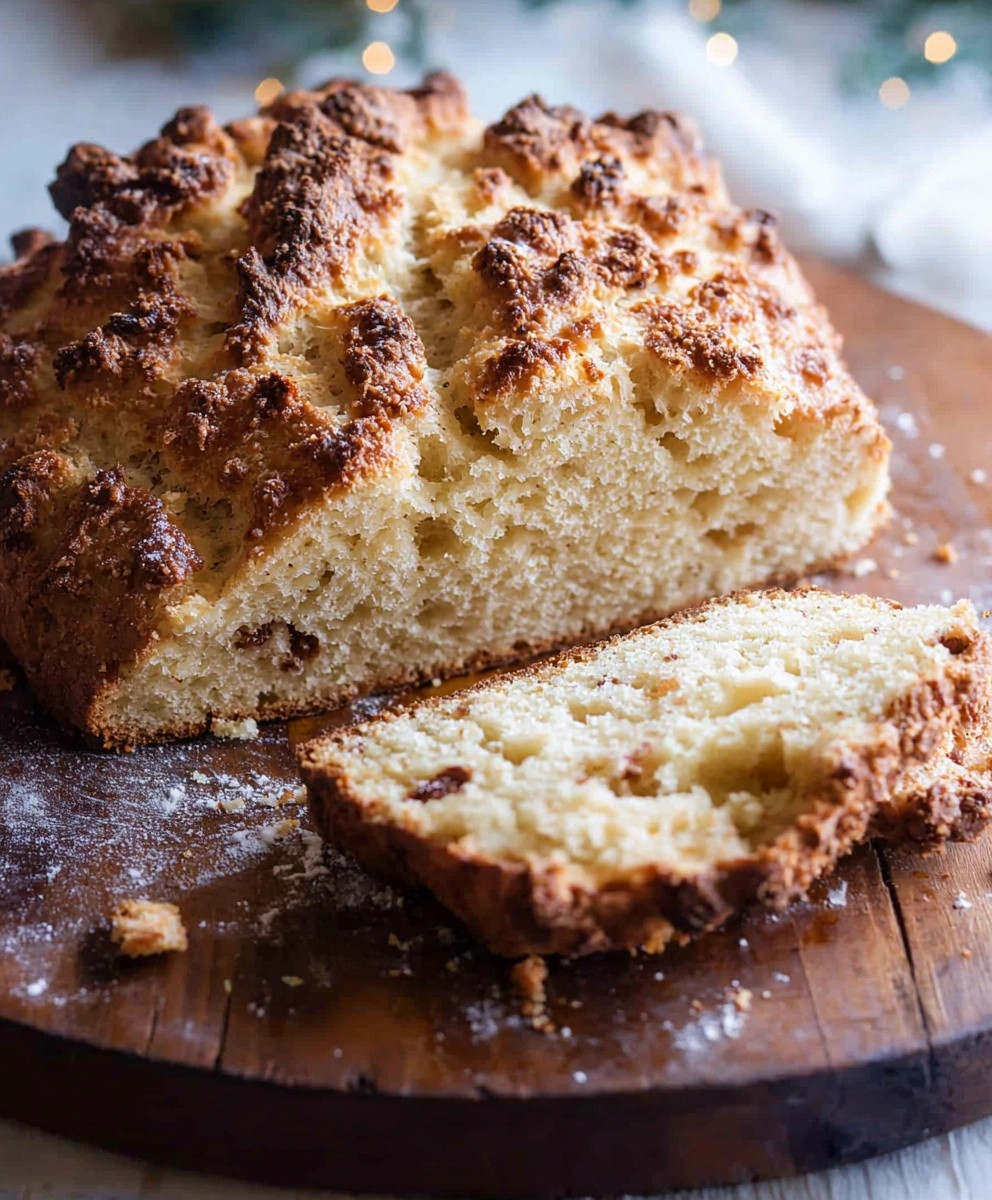
Conclusion:
In summary, this Irish Soda Bread recipe is a must-try for anyone looking to experience the warm, comforting flavors of traditional Irish baking. Its simplicity and quick preparation make it an ideal choice for both novice and experienced bakers alike. The delightful combination of baking soda and buttermilk not only creates a unique texture but also infuses the bread with a subtle tang that pairs beautifully with a variety of accompaniments. For serving suggestions, consider enjoying your freshly baked Irish Soda Bread with a generous spread of butter and a dollop of homemade jam for a classic treat. Alternatively, it pairs wonderfully with hearty soups or stews, making it a perfect addition to your family dinners. If you’re feeling adventurous, try adding ingredients like raisins or caraway seeds for a twist on the traditional recipe, or experiment with whole wheat flour for a nuttier flavor. We encourage you to try this Irish Soda Bread recipe and share your experience with friends and family. Whether you enjoy it warm from the oven or toasted the next day, we would love to hear how it turned out for you. Dont forget to share your photos and variations on social media, and let the world know about your delicious creation. Happy baking! Print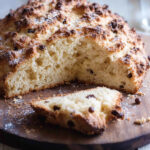
Irish Soda Bread: A Traditional Recipe for Perfectly Fluffy Loaves
- Total Time: 50 minutes
- Yield: 1 loaf (approximately 8 servings) 1x
Description
This traditional Irish Soda Bread is a quick and easy recipe that results in a soft, slightly sweet loaf. Ideal for breakfast or as a side dish, it can be customized with optional add-ins like raisins or currants for added flavor. Enjoy it warm with butter, jam, or as part of a hearty meal.
Ingredients
- 4 cups all-purpose flour
- 1 teaspoon baking soda
- 1 teaspoon salt
- 1 ¾ cups buttermilk
- 2 tablespoons unsalted butter (optional, for brushing)
- 1 tablespoon sugar (optional, for a slightly sweet flavor)
- 1 cup raisins or currants (optional, for a fruitier bread)
Instructions
- Preheat your oven to 425°F (220°C). Line a baking sheet with parchment paper or lightly grease it to prevent sticking.
- In a large mixing bowl, combine the flour, baking soda, salt, and sugar (if using). Whisk together until well blended.
- If you are adding raisins or currants, fold them into the dry ingredients at this stage.
- Make a well in the center of the dry ingredients. Pour in the buttermilk gradually, starting with about 1 ½ cups. Mix until the dough comes together, adding more buttermilk as needed.
- Turn the dough onto a lightly floured surface and knead gently for about 1-2 minutes.
- Shape the dough into a round loaf, about 1 ½ inches thick.
- Transfer the loaf onto the prepared baking sheet. Score a deep cross on the top of the loaf with a sharp knife.
- If desired, melt the butter and brush it over the top of the loaf.
- Bake the bread for 30-35 minutes, or until golden brown and sounds hollow when tapped on the bottom. The internal temperature should reach about 190°F (88°C).
- Remove the bread from the oven and let it cool on a wire rack for at least 10 minutes before slicing.
- Serve warm with butter, jam, or honey. For a traditional Irish breakfast, pair it with eggs, bacon, and sausages.
- Store leftovers in an airtight container at room temperature for up to 2 days or freeze for up to 3 months.
Notes
- Use fresh baking soda for the best rise.
- Buttermilk is essential for flavor; substitute with milk mixed with vinegar or lemon juice if needed.
- Customize with nuts, seeds, or different dried fruits.
- For a crustier loaf, place a shallow pan of water in the oven while baking.
- Prep Time: 15 minutes
- Cook Time: 35 minutes


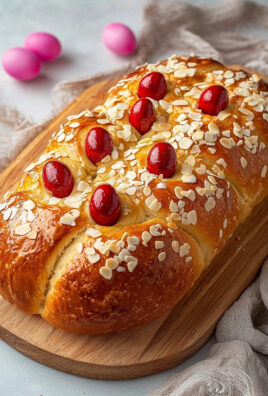
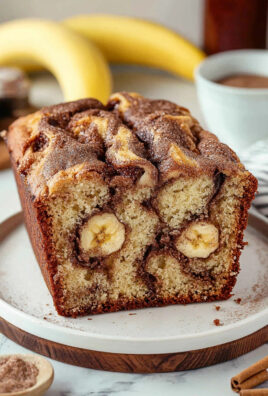
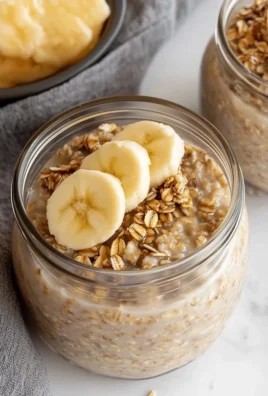
Leave a Comment